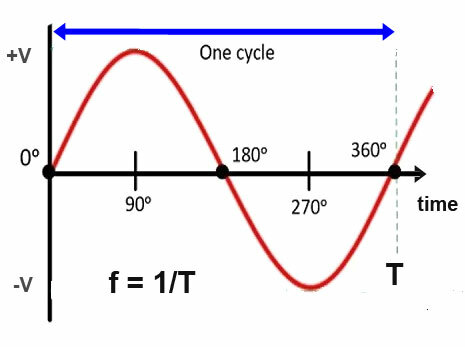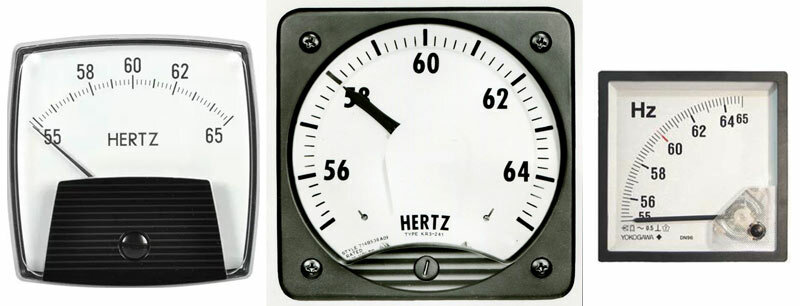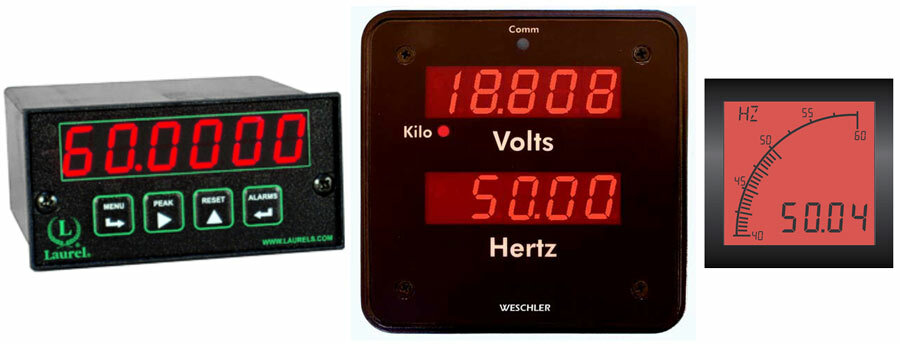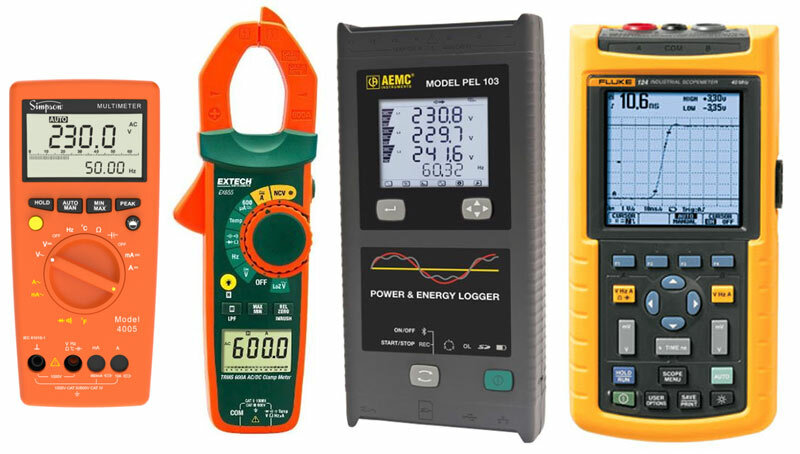Frequency is an important parameter for an ac waveform. The frequency, in Hertz, is defined as the number of cycles per second. It can also be expressed as 1/T, where T is the time for one cycle. One period is the duration of one complete cycle, in seconds.  The signal waveform can be a sine wave, distorted sine wave, square wave or pulse train. The definition of frequency still applies. Non-sinusoidal waveforms contain harmonics that are multiples of the fundamental frequency. Meters that measure line frequency are measuring this fundamental frequency. Both panel-mounted and portable instruments are able to make this power line (mains) measurement.
The signal waveform can be a sine wave, distorted sine wave, square wave or pulse train. The definition of frequency still applies. Non-sinusoidal waveforms contain harmonics that are multiples of the fundamental frequency. Meters that measure line frequency are measuring this fundamental frequency. Both panel-mounted and portable instruments are able to make this power line (mains) measurement.
Analog Meters
Analog-style line frequency meters are designed for a specific frequency and measure a few Hertz on either side of nominal. Users order a meter based on input voltage and center frequency. Originally these meters used a tuned circuit to center the pointer with a nominal input. A higher or lower frequency unbalanced the circuit and shifted the pointer either left or right. Now most meters use an electronic circuit to convert frequency to a DC current and drive the pointer movement. Shown here are three meters for 60Hz systems: a 3.5″ Yokogawa panel meter, a 4″ Weschler switchboard meter, and a 72mm Crompton DIN meter. Basic accuracy for the typical panel meter is 3% of span or 0.3Hz.  Switchboard and DIN meters are 1% or 0.5% accuracy class. Regardless of case style or internal construction, these meters have only two terminals and are simple to install. They are self-contained (no external power is needed) and connect across the line being measured in the same way as a voltmeter. Sealed, ruggedized or high-shock models can be specified for severe environments. Some international models are available to handle both 50 & 60Hz. Their standard scale spans 45 to 65 Hertz. The standard scale for 400Hz units is 360-440Hz, although a different span can be ordered.
Switchboard and DIN meters are 1% or 0.5% accuracy class. Regardless of case style or internal construction, these meters have only two terminals and are simple to install. They are self-contained (no external power is needed) and connect across the line being measured in the same way as a voltmeter. Sealed, ruggedized or high-shock models can be specified for severe environments. Some international models are available to handle both 50 & 60Hz. Their standard scale spans 45 to 65 Hertz. The standard scale for 400Hz units is 360-440Hz, although a different span can be ordered.
Digital Meters
 Digital meters can use an electronic circuit to convert the frequency to a DC voltage and an analog-to-digital converter to drive a display. However, most use digital signal processing for more precision and speed. The simplest approach, counting line cycles, may be sufficient for frequency measurements above 1kHz. However, at 60Hz, with a one-second measurement time, this technique would provide only a reading resolution of 1Hz. To obtain a resolution of 0.01Hz would require a 100-second measurement time, which is too slow to be practical. One method to quickly get more resolution is to use a reciprocal counting technique. Instead of counting input cycles, the meter counts clock cycles from an accurate internal oscillator. The gate time, during which these pulses are counted, is varied slightly based on the input signal. This achieves resolution of 0.01Hz or better, with an update rate of 1s or less. At this resolution, harmonics or noise can cause jitter in the frequency reading. Some meters have an adjustable trigger level or a low pass filter that can be activated to stabilize the display. Another digital technique for measuring frequency is to rapidly sample the ac waveform many times during one input cycle. From this data, the exact period is determined and the frequency calculated.
Digital meters can use an electronic circuit to convert the frequency to a DC voltage and an analog-to-digital converter to drive a display. However, most use digital signal processing for more precision and speed. The simplest approach, counting line cycles, may be sufficient for frequency measurements above 1kHz. However, at 60Hz, with a one-second measurement time, this technique would provide only a reading resolution of 1Hz. To obtain a resolution of 0.01Hz would require a 100-second measurement time, which is too slow to be practical. One method to quickly get more resolution is to use a reciprocal counting technique. Instead of counting input cycles, the meter counts clock cycles from an accurate internal oscillator. The gate time, during which these pulses are counted, is varied slightly based on the input signal. This achieves resolution of 0.01Hz or better, with an update rate of 1s or less. At this resolution, harmonics or noise can cause jitter in the frequency reading. Some meters have an adjustable trigger level or a low pass filter that can be activated to stabilize the display. Another digital technique for measuring frequency is to rapidly sample the ac waveform many times during one input cycle. From this data, the exact period is determined and the frequency calculated.
Another factor to consider in frequency meters is input level. Many digital counters can measure mains frequency with adequate resolution, but their input cannot be connected directly to an ac power line. Typically, these meters are limited to a unipolar input of 0 to 30V peak. Some may only accept logic level signals. Shown here are examples of digital frequency meters that can be directly connected to mains circuits. The Laurel Laureate Counter (left) has a 0.005Hz to 1MHz bandwidth. It measures 50 or 60 Hertz to better than 1mHz resolution, in just a few line cycles. Maximum input is 250VAC. Three selectable noise filters help stabilize readings and the displayed resolution can be reduced if the full six digits are not needed. For applications that don’t require this level of performance, the Laurel L40 (not shown) is a universal input meter that measures frequency on any AC voltage or AC current range (up 400V and 5A). It offers 15-100Hz bandwidth, 0.1Hz resolution, 0.15% accuracy and 10 updates per second. Some meters measure frequency along with other power line parameters, such as V, A, W, or VA. The Weschler 2492 dual display switchboard meter (center) accepts a mains voltage input up to 600V. For higher voltages, the volts readout can be scaled to display the primary voltage of a potential transformer (kilo multiplier is illuminated in the photo). Frequency resolution is 0.01Hz at 50/60Hz. The Trumeter APM-FREQ (right) is a low-cost frequency meter with LCD display. It has a 400Hz bandwidth and 0.1% frequency accuracy on AC inputs to 500V or 5A. External power of 12-24VAC/DC is required. The other meters operate from either mains power or a low voltage supply. Meters with wide bandwidth may also be suitable for measuring frequency on 25Hz or 400Hz systems, motor generators and variable frequency drives.
Test Equipment
 Many portable test tools also include line frequency capability. Advanced digital multimeters measure the frequency of an AC voltage or current input. The 6600 count Simpson 4006 (left) has a frequency measurement range of 10Hz to 10MHz. Its dual display shows a line frequency reading, to 0.01Hz resolution, in addition to the volts or amps value. The meter is overload-protected to 1000V. Many clamp multimeters include a frequency function. The Extech EX655 is a 600A TRMS meter that makes 10Hz to 1MHz frequency measurements with the voltage test leads and has 0.01Hz resolution at 50/60Hz. Some clamp meters also make non-contact frequency measurements on a wire running through the jaws. Power Analyzers and Power Loggers are test equipment categories that usually include line frequency measurement capability. These products employ high-speed sampling to determine frequency. One example is the AEMC PEL103, which records over 20 power parameters and displays line frequency to 0.01Hz. Handheld oscilloscopes are versatile test tools that make frequency measurements. The Fluke 124B Industrial ScopeMeter has two input channels and 40MHz bandwidth. In addition to displaying waveforms, it has a built-in multimeter that measures line frequency to 0.01Hz.
Many portable test tools also include line frequency capability. Advanced digital multimeters measure the frequency of an AC voltage or current input. The 6600 count Simpson 4006 (left) has a frequency measurement range of 10Hz to 10MHz. Its dual display shows a line frequency reading, to 0.01Hz resolution, in addition to the volts or amps value. The meter is overload-protected to 1000V. Many clamp multimeters include a frequency function. The Extech EX655 is a 600A TRMS meter that makes 10Hz to 1MHz frequency measurements with the voltage test leads and has 0.01Hz resolution at 50/60Hz. Some clamp meters also make non-contact frequency measurements on a wire running through the jaws. Power Analyzers and Power Loggers are test equipment categories that usually include line frequency measurement capability. These products employ high-speed sampling to determine frequency. One example is the AEMC PEL103, which records over 20 power parameters and displays line frequency to 0.01Hz. Handheld oscilloscopes are versatile test tools that make frequency measurements. The Fluke 124B Industrial ScopeMeter has two input channels and 40MHz bandwidth. In addition to displaying waveforms, it has a built-in multimeter that measures line frequency to 0.01Hz.
These are just a few examples of line frequency measurement products in the Weschler catalog. Whether for a fixed installation or portable use, a variety of test and measurement instrumentation is available to monitor the power line (mains) frequency in AC systems. In addition to a local readout, many of these instruments include a communication interface to transmit frequency data to a control system or analysis platform.
